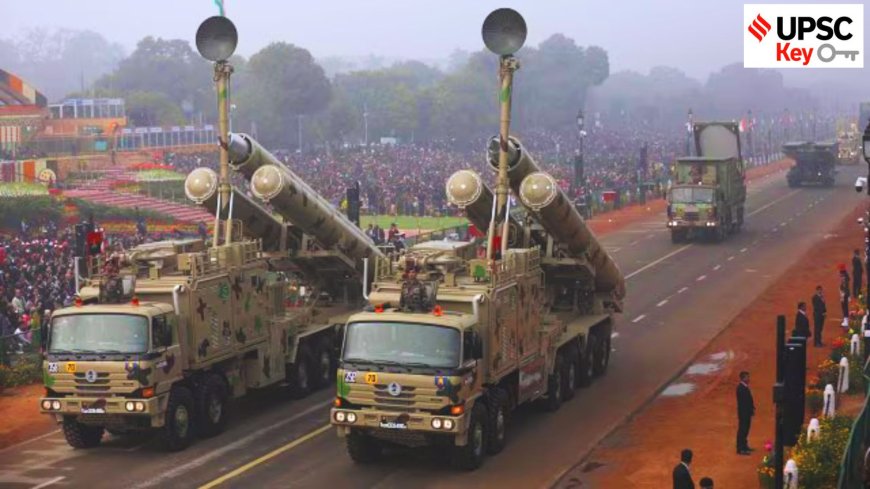UPSC Key: BrahMos missile, US-China Geneva talks, and India-Pakistan ceasefire declaration

Asarkari - Sarkari News, Jobs & Updates
UPSC Key: Decoding BrahMos, US-China Dialogue, and Indo-Pak Ceasefire Dynamics
kam sabdo me kahein to, this article delves into crucial international and defense developments – the BrahMos missile's advancements, the strategic US-China talks in Geneva, and the evolving India-Pakistan ceasefire – offering essential insights for UPSC aspirants and informed citizens alike.
Authored by Priya Sharma and Ananya Singh
Introduction: Connecting the Dots for Comprehensive Understanding
The global geopolitical landscape is in constant flux, presenting a dynamic array of challenges and opportunities for nations worldwide. For aspirants preparing for the prestigious UPSC Civil Services Examination, staying abreast of these developments is not just beneficial but essential. Key events in defense technology, international diplomacy, and regional stability often find their way into both the preliminary and main examinations. This article unpacks three such significant topics: the strategic prowess of the BrahMos missile, the nuanced US-China talks in Geneva concerning emerging technologies like AI, and the delicate state of the India-Pakistan ceasefire declaration. Understanding these interconnected themes provides a holistic view crucial for a well-rounded preparation and for any citizen keen on understanding India's strategic environment.
BrahMos Missile: India's Supersonic Edge
The BrahMos missile system stands as a testament to India's growing indigenous defense capabilities and its strategic partnerships. A joint venture between India's Defence Research and Development Organisation (DRDO) and Russia's NPO Mashinostroyeniya, BrahMos is a versatile supersonic cruise missile that has significantly bolstered India's offensive firepower across all three services of the armed forces.
Technological Prowess and Variants
Named after the Brahmaputra river of India and the Moskva river of Russia, the BrahMos is renowned for its speed (Mach 2.8 to Mach 3), precision, and ability to be launched from land, air, sea, and underwater platforms. This multi-platform capability makes it a formidable weapon. Recent advancements include the successful testing of extended-range versions, reportedly capable of hitting targets beyond 500 kilometers, a significant leap from its initial range. Furthermore, the development of BrahMos-NG (Next Generation), a lighter and smaller version, is underway, designed for integration with a wider array of platforms, including smaller fighter aircraft like the LCA Tejas. Its "fire and forget" principle of operation allows the launching platform to take evasive action immediately after firing, enhancing survivability.
Strategic Significance and 'Make in India'
The BrahMos missile system is a cornerstone of India's deterrence strategy, providing a credible conventional strike capability. Its induction has enhanced India's strategic autonomy and offensive punch. Beyond its domestic importance, BrahMos is also a flagship product for India's ambitions as a defense exporter. The landmark deal with the Philippines for the shore-based anti-ship variant of BrahMos has paved the way for further export opportunities, aligning perfectly with the 'Make in India' and 'Aatmanirbhar Bharat' initiatives in the defense sector. Several other nations in Southeast Asia and the Middle East have also expressed interest, highlighting its global appeal.
UPSC Lens: Where BrahMos Fits In
For UPSC aspirants, BrahMos is relevant under GS Paper III (Science & Technology – developments and their applications and effects in everyday life; Achievements of Indians in science & technology; indigenization of technology and developing new technology; Security – various security forces and agencies and their mandate). Questions can revolve around its technical specifications, strategic implications, role in India's defense industrial base, and its contribution to India's foreign policy objectives through defense exports.
US-China Geneva Talks: Navigating AI and Strategic Stability
The relationship between the United States and China, the world's two largest economies, is arguably the most consequential bilateral dynamic shaping global affairs. Amidst ongoing competition and tensions across various domains – trade, technology, and geopolitical influence – structured dialogues are crucial for managing risks and preventing miscalculations. The recent talks in Geneva, particularly those focusing on Artificial Intelligence (AI), exemplify this cautious engagement.
Key Agendas: AI Risks and Nuclear Concerns
A significant recent meeting in Geneva, held in May 2024, saw US and Chinese officials discuss the risks associated with advanced AI. This was a follow-up to commitments made by Presidents Biden and Xi to manage the intense competition responsibly. The dialogue aimed to foster a shared understanding of AI safety, how the technology might be used in military applications, and the potential for AI to destabilize strategic calculations. While not formal arms control negotiations, these discussions touch upon similar concerns about new technologies impacting warfare and global stability. Broader US-China dialogues also periodically address nuclear stockpiles and strategic doctrines, though formal treaties remain elusive, unlike past US-Russia frameworks.
Outcomes and Global Implications
The primary outcome of such talks is often the process itself – maintaining open lines of communication to prevent conflict. On AI, both sides reportedly shared their perspectives on managing its development and deployment, especially concerning autonomous weapon systems. While breakthroughs are rare, these conversations can lay the groundwork for future, more concrete measures. The implications are global: a stable US-China relationship, or at least one where risks are managed, is vital for international peace and economic predictability. For India, a less volatile great power rivalry allows more diplomatic space and reduces the pressure to navigate complex alignments, though it also presents its own set of strategic considerations.
UPSC Lens: Understanding Great Power Politics
This topic falls squarely under GS Paper II (International Relations – Bilateral, regional and global groupings and agreements involving India and/or affecting India’s interests; Effect of policies and politics of developed and developing countries on India’s interests). Aspirants should analyze the nature of US-China competition, the role of technology as a new frontier of this competition, and the implications for India's foreign policy, strategic autonomy, and its own technological development path.
India-Pakistan Ceasefire Declaration: A Precarious Calm
The Line of Control (LoC) separating Indian and Pakistani-administered Kashmir has historically been one of the world's most volatile frontiers. In a welcome development, the Directors General of Military Operations (DGMOs) of India and Pakistan announced a renewed commitment to uphold all ceasefire agreements, effective from midnight of February 24-25, 2021.
The Ceasefire's Journey: A Respite with Caveats
Since its reiteration, the 2021 ceasefire has largely held, leading to a significant reduction in cross-border firing incidents and, consequently, a respite for civilian populations living along the LoC. This period of relative calm has been one of the longest sustained in recent memory. However, the underlying political issues and the trust deficit between the two nations remain deeply entrenched. While overt military clashes have decreased, challenges like infiltration attempts and drone activities continue to test the fragile peace. Both sides periodically reaffirm their commitment, but the sustainability of the ceasefire often hinges on the broader political climate and the absence of major provocations.
Beyond the LoC: Broader Implications for Bilateral Ties
A stable LoC is a necessary, though not sufficient, condition for any meaningful improvement in India-Pakistan relations. While the ceasefire has created a more conducive environment for dialogue, formal talks remain suspended. India has consistently maintained that an atmosphere free from terror and hostility is essential for engagement. The ceasefire's success demonstrates that mechanisms for de-escalation can work, but translating this into a broader peace process requires addressing core issues, including cross-border terrorism, which remains a primary concern for India. The internal political dynamics within Pakistan also play a significant role in shaping its approach towards India.
UPSC Lens: India's Neighborhood and Security Challenges
This is crucial for GS Paper II (India and its Neighborhood- Relations) and GS Paper III (Security Challenges and their Management in Border Areas; Linkages of Organized Crime with Terrorism). Questions may focus on the factors contributing to the ceasefire's relative success, the challenges to its long-term viability, its impact on the lives of border populations, and its role within the larger framework of India-Pakistan relations and regional security.
Asarkari Commentary: Interlinkages and India's Strategic Imperatives
The three distinct topics discussed – BrahMos's technological might, US-China's cautious dialogue on AI, and the Indo-Pak ceasefire – are not isolated events. They are threads in the complex tapestry of contemporary international relations and India's strategic calculus. The development and potential export of systems like BrahMos underscore India's pursuit of 'strategic autonomy' and self-reliance in defense. This is particularly pertinent in an era where great power competition, exemplifie
What's Your Reaction?
 Like
0
Like
0
 Dislike
0
Dislike
0
 Love
0
Love
0
 Funny
0
Funny
0
 Angry
0
Angry
0
 Sad
0
Sad
0
 Wow
0
Wow
0











































